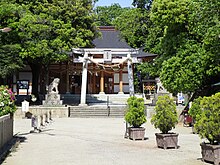User:Immanuelle/Akashi no Kuni no Miyatsuko
Appearance
| This user page or section is currently being expanded by an editor. You are welcome to help in expanding too. If this page has not been changed in several days, please remove this template. This page was last edited by Davey2010 (talk | contribs) 2 months ago. |
罪 is a Chinese character. It is one of the Kyōiku kanji or Kanji taught in elementary school in Japan.[1] It is a fifth grade kanji[1].
Content taken from Draft:Furutama-no-mikoto
[change | change source]| This user page or section is currently being expanded by an editor. You are welcome to help in expanding too. If this page has not been changed in several days, please remove this template. This page was last edited by Davey2010 (talk | contribs) 2 months ago. |
| Immanuelle/Akashi no Kuni no Miyatsuko | |
|---|---|
 Yagi Shrine a shrine that worships him | |
| Major cult centre | Yagi Shrinesimple:User:Immanuelle/Furutama |
| Personal information | |
| Children | Takeuioki no mikoto , Amanosakitama no mikoto , Kuroshima Isone hime, Ohonutehime |
| Parents |
|
Furutama-no-mikoto (布留多摩命) is a son of Watatsumi. He is an ancestor of many clans including the Owari clan, the Yamato clan, the Kamo clan, the Kubiki Kokuzo, the Akashi Kokuzo and the Yagi clan of which he is also the Ujigami worshipped at Yagi Shrine.
He had several children including Takeuioki no mikoto|, Amanosakitama no mikoto|, Kuroshima Isone hime, Ohonutehime
Family tree
[change | change source]- Pink is female.
- Blue is male.
- Grey means other or unknown.
- Clans, families, people groups are in green.
References
[change | change source]- ↑ 1.0 1.1 "The Kyoiku Kanji (教育漢字) - Kanshudo". www.kanshudo.com. Archived from the original on March 24, 2022. Retrieved 2023-05-06.
- ↑ 2.0 2.1 2.2 2.3 Matoshi Suzuki Hyakka Keizu Kou (百家系図稿)
- ↑ 3.0 3.1 3.2 Akima, Toshio (1993). "The Origins of the Grand Shrine of Ise and the Cult of the Sun Goddess Amaterasu Ōmikami". Japan Review. 4 (4): 143. ISSN 0915-0986. JSTOR 25790929.
- ↑ 右京神別地祇部「八木造」条。
- ↑ 5.0 5.1 "Ofune Matsuri – A Unique Festival in Nagano, Japan! - Festivals & Events|COOL JAPAN VIDEOS|A Website With Information About Travel, Culture, Food, History, and Things to Do in Japan". cooljapan-videos.com. Retrieved 2023-12-06.
- ↑ "八坂刀売神(ヤサカトメノカミ". 日本の神様辞典 (Nihon no Kamisama Jiten). Archived from the original on June 25, 2017. Retrieved May 27, 2017.
- ↑ 7.0 7.1 Picken, Stuart D.B. (28 December 2010). Historical Dictionary of Shinto. Scarecrow Press. p. 288. ISBN 978-0810871724.
- ↑ Mizue, Mori (10 May 2005). "Toyotamabime". Encyclopedia of Shinto. Retrieved 2010-09-29.
- ↑ Mizue, Mori (22 April 2005). "Hohodemi". Encyclopedia of Shinto. Retrieved 2010-09-29.
- ↑ 中田憲信「尾張氏」『諸系譜』第二冊。
- ↑ 11.0 11.1 Yasumaro. O, translated by Gustav Heldt. (2014) “Kojiki. An Account of Ancient Matters”. New York: Columbia University Press.
- ↑ 12.0 12.1 Ponsonby, F. (1959) “The Imperial House of Japan.” Kyoto: Ponsonby Memorial Society.
- ↑ Mizue, Mori (12 May 2005). "Ugayafukiaezu". Encyclopedia of Shinto. Retrieved 2010-09-29.
- ↑ 14.0 14.1 "鵜葺草葺不合命" [Ugayafukiaezu]. Kokushi Daijiten (in Japanese). Tokyo: Shogakukan. 2012. OCLC 683276033. Archived from the original on 2007-08-25. Retrieved 2012-12-04.
- ↑ 15.0 15.1 Hoga, Toshio (2006). Tango no Amabe-shi no Shutsuji to sono ichizoku, Kokigi no Heya (丹後の海部氏の出自とその一族). Japan.
{{cite book}}: CS1 maint: location missing publisher (link) - ↑ 16.0 16.1 "Encyclopedia of Shinto詳細". 國學院大學デジタルミュージアム (in Japanese). Retrieved 2023-10-27.
- ↑ 17.0 17.1 https://rekihaku.pref.hyogo.lg.jp/wp-content/themes/rekihaku/assets/pdf/harimanokunifudoki/english/chapter_3_5.pdf
- ↑ Norinaga Motoori (2007). The Poetics of Motoori Norinaga: A Hermeneutical Journey. University of Hawaii Press. p. 191. ISBN 978-0-8248-3078-6.
- ↑ "神八井耳命(カムヤイミミノミコト)". nihonsinwa.com (in Japanese). Retrieved 2023-01-17.
- ↑ "Book III", Nihongi: Chronicles of Japan from the Earliest Times to A.D. 697, Volume 1, retrieved 2023-03-09 (called Kami-ya-wi-mimi in this source)
- ↑ 21.0 21.1 Chamberlain, Basil. [SECT. LXV.—EMPEROR SŪ-JIN (PART III: STORY OF OHO-TATA-NE-KO'S BIRTH)] (The Kojiki). Read before the Asiatic Society of Japan on April 12, May 10, and June 21, 1882, reprinted in 1919. p. 219.
His Augustness Oho-tata-ne-ko ... was the ancestor of the Dukes of Miwa and ofuruf the Dukes of Kamo.
- ↑ 右京神別地祇部「八木造」条。
- ↑ Takano, Tomoaki; Uchimura, Hiroaki (2006). History and Festivals of the Aso Shrine. Aso Shrine, Ichinomiya, Aso City.: Aso Shrine.
- ↑ Grapard, Allan G. (2023-04-28). The Protocol of the Gods: A Study of the Kasuga Cult in Japanese History. University of California Press. ISBN 978-0-520-91036-2.
- ↑ Tenri Journal of Religion. Tenri University Press. 1968.
- ↑ 26.0 26.1 26.2 "余曽多本毘売命(ヨソタホビメノミコト)". nihonsinwa.com (in Japanese). Retrieved 2023-01-19.
- ↑ 27.0 27.1 27.2 Ponsonby-Fane, R. A. B. (2016-05-11). "Atsuta Jingu". Studies In Shinto & Shrines (1st ed.). Routledge. ISBN 978-1-138-98322-9.
This page will be placed in the following categories if it is moved to the article namespace.
Categories: References
[change | change source]This page will be placed in the following categories if it is moved to the article namespace.
Categories: - Kanji
- Kyōiku kanji
- Kuni no miyatsuko families
- Shake clans
- Dd
- Draft articles This draft article is taken from my draft article on complex english wikipedia. Due to technical issues I cannot easily link the source article, but it is under [[en:draft:XXX]] instead of [[simple:User:Immanuelle/XXX]] so in the future fix the interlanguagelink here en:draft:Immanuelle/Akashi no Kuni no Miyatsuko to en:draft:XXX accordingly. Do not fix the following ill User:Immanuelle ❤️💚💙 User_talk:Immanuelle 03:52, 29 April 2024 (UTC)
This page will be placed in the following categories if it is moved to the WP:NS0.
Help:Category:
Cite error: There are <ref group=lower-alpha> tags or {{efn}} templates on this page, but the references will not show without a {{reflist|group=lower-alpha}} template or {{notelist}} template (see the help page).
